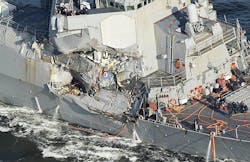Bills start coming due for last summer's naval ship collisions
The tab so far is $107.9 million; that's the estimated cost to repair the Navy guided missile destroyer USS Fitzgerald (DDG 62), which last 17 June collided with the Philippine-flagged container ship MV ACX Crystal off the east coast of Japan.
The accident killed seven of the Fitzgerald's crew, ripped open the ship's hull below the waterline, destroyed the captain's cabin, and seriously injured the Fitzgerald's commanding officer, Cmdr. Bryce Benson, as well as two other sailors.
The container ship's bulbous bow penetrated the Fitzgerald's hull below the waterline, flooding a machinery space, the radio room, and two crew berthing spaces with sea water. Many of the Fitzgerald's fatalities died in their bunks when their living compartments quickly flooded.
It was only through heroic efforts of the ship's damage-control personnel that the destroyer was kept afloat, so serious was the damage. With a less-competent group, the ship might have sunk with little prospects for salvage.
Related: Two Navy surface warship maritime collisions in two months; what's going on in the Pacific?
Now, after untold suffering and grief among families and shipmates of the Fitzgerald's crew who died, it's going to cost at least $107.9 million to have the ship fixed -- and we may be just getting started. The Fitzgerald is scheduled to arrive in Pascagoula, Miss., sometime this month after being moved aboard a transport ship from its home port in Yokosuka, Japan.
Officials of the Naval Sea Systems Command in Washington announced a $63 million contract modification this week to Huntington Ingalls Industries in Pascagoula for the repair and restoration of the Fitzgerald. This contract provides for the initial collision ripout phase, which will include a combination of maintenance, modernization, and collision repair of the vessel.
Last September Huntington Ingalls won a $29.4 million contract to start planning the Fitzgerald's repair and restoration. It doesn't end there. Last 22 Sept. the Lockheed Martin Corp. Rotary and Mission Systems segment in Moorestown, N.J., won a $15.5 million Navy contract modification to build and install a new SPY-1D radar array, water cooler, and 11 high-voltage power supply cables for the Fitzgerald repair. It's adding up to one hefty pricetag.
It's not just about the money. Certainly we can't put a dollar figure on human suffering. The families and shipmates of the Fitzgerald's dead have been through a lot in the aftermath of the tragedy.
It wasn't just the Fitzgerald that was involved in maritime accidents in the Western Pacific last summer. Last 21 Aug. the guided missile destroyer USS John S. McCain (DDG 56) collided with the oil and chemical tanker ALNIC MC in the Straits of Malacca near Singapore.
Related: Navy to consider whether crashed warships were hacked
Ten Navy sailors died in the McCain collision ... similar circumstances, similar damage to the Fitzgerald, and the cost of repairing and restoring the McCain likely will be similar. For the Navy's part, we can hope there will be some serious lessons learned from these mishaps.
It's becoming clear that neither accident involved anything so nefarious as computer hacking, purposeful targeting of the Navy vessels, or willful negligence of anyone involved. These accidents involved cascades of mistakes on top of one another -- as most serious accidents do.
Yet if we can point fingers, then the continued uptempo operations that confront Navy ship crews in an era of lean defense budgets and downward pressure on Navy manning requirements should come under scrutiny.
Put simply, the Navy is trying to do too much with too little. Yes, technology can compensate for reduced personnel levels and shrinking budgets, yet the crews aboard those vessels are only human, and are under staggering and sustained workloads. Evidently it's been that way for a long time.
We hear it all the time: the military needs to do more with less. Well perhaps we've crossed a threshold where the military simply can no longer do what's expected with the resources available. Things like this happen when the wheels start coming off. How to deal with this should be a top priority for the Trump Administration.
Ready to make a purchase? Search the Military & Aerospace Electronics Buyer's Guide for companies, new products, press releases, and videos
